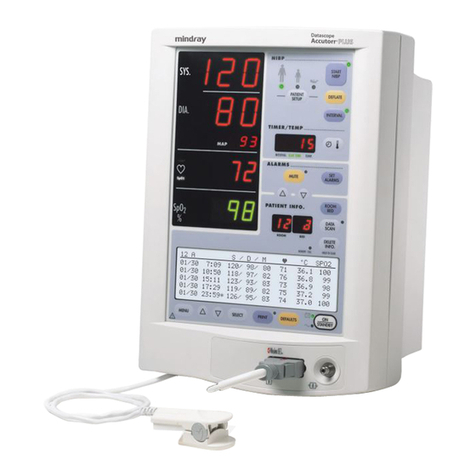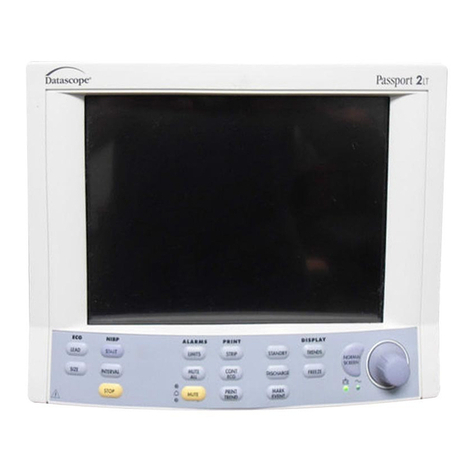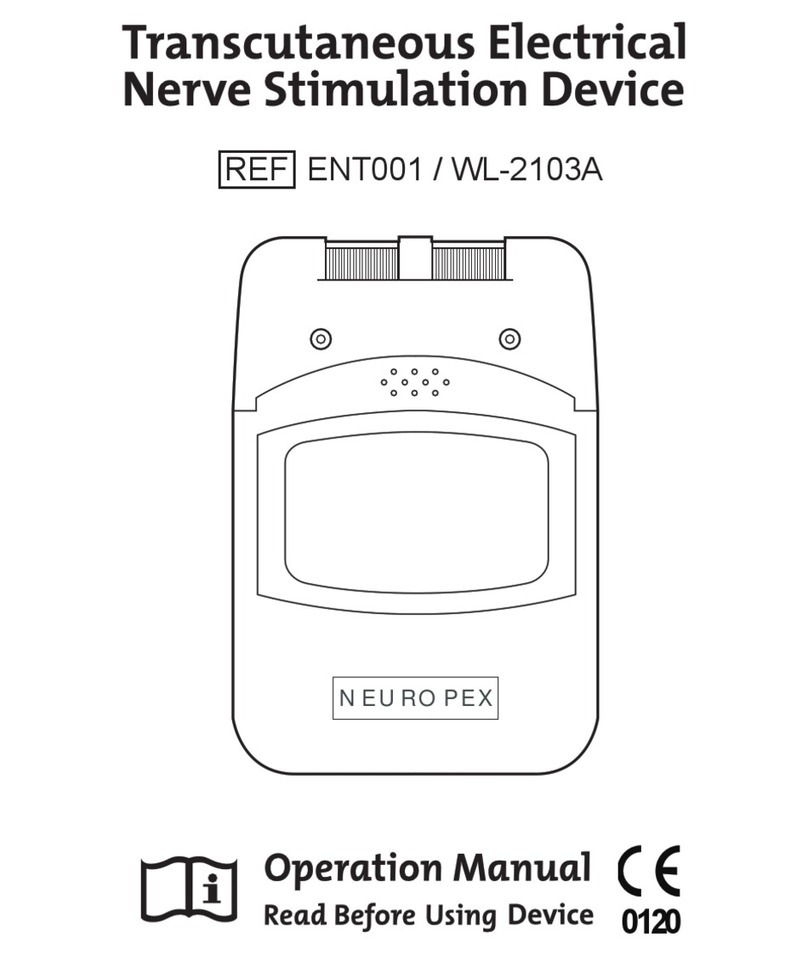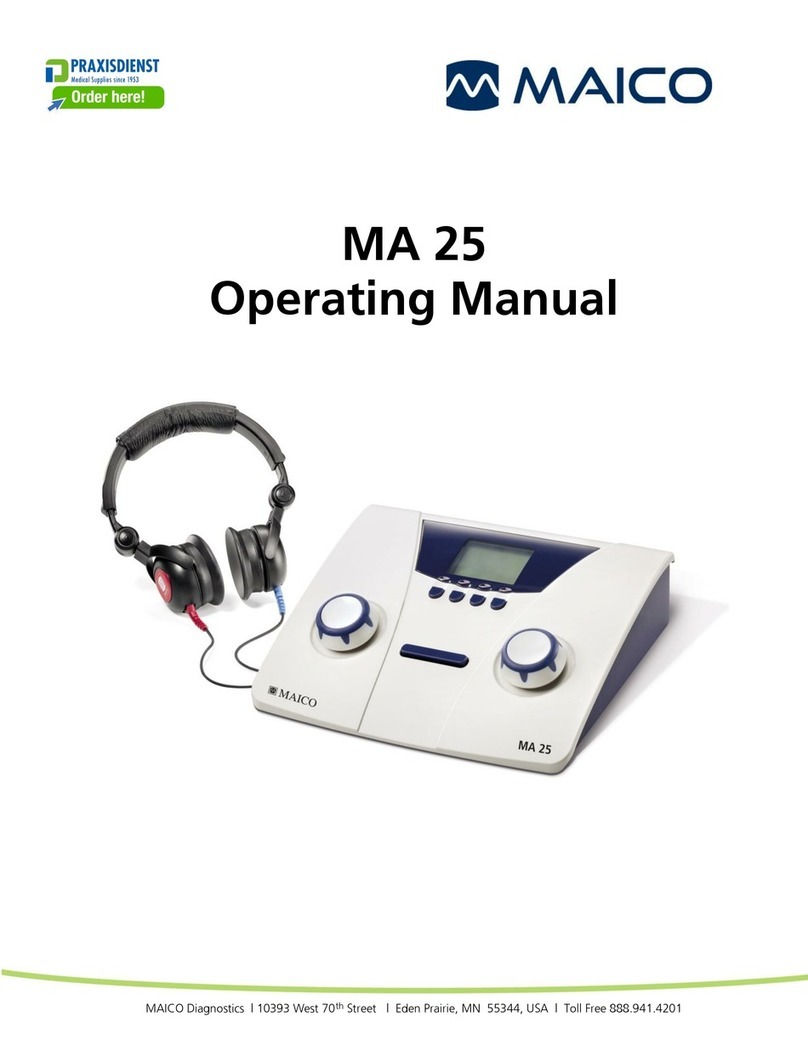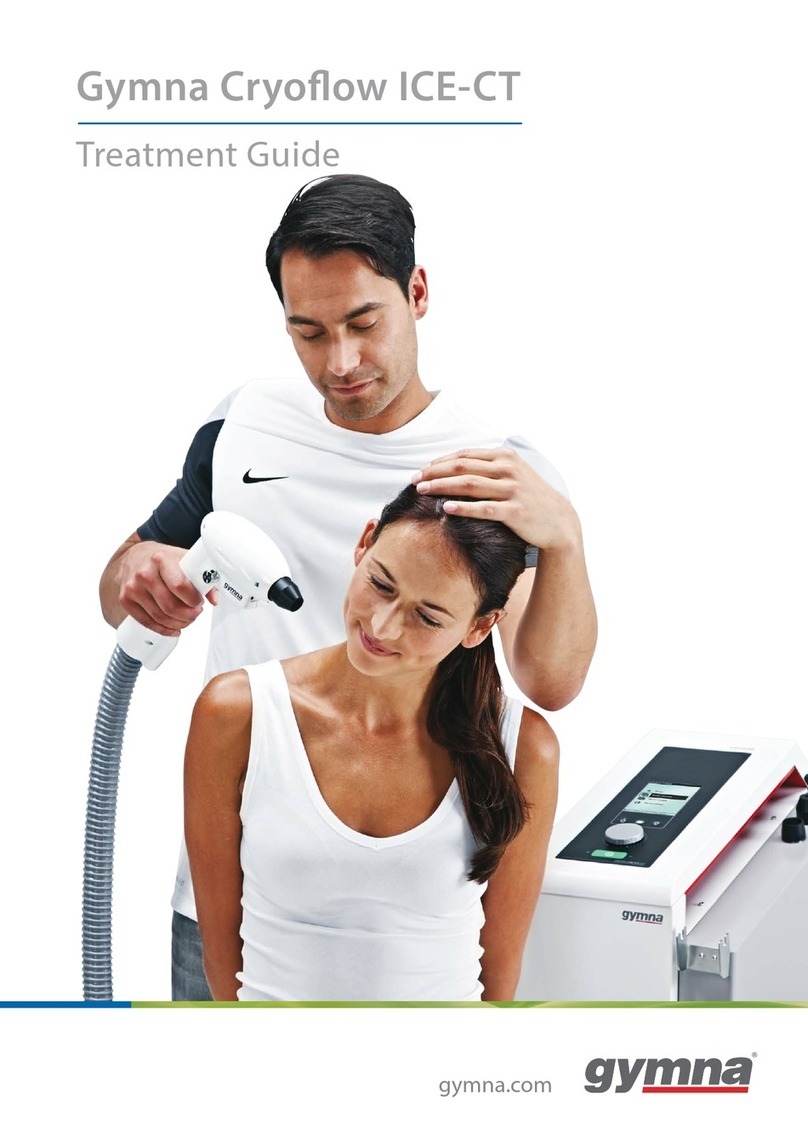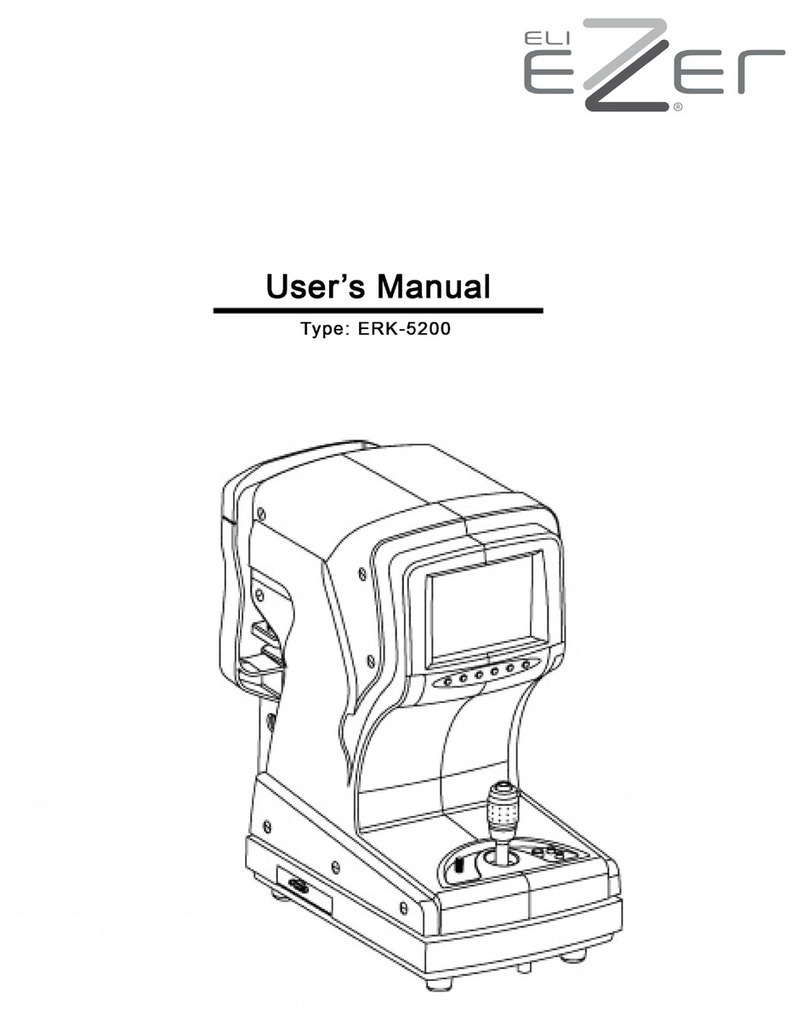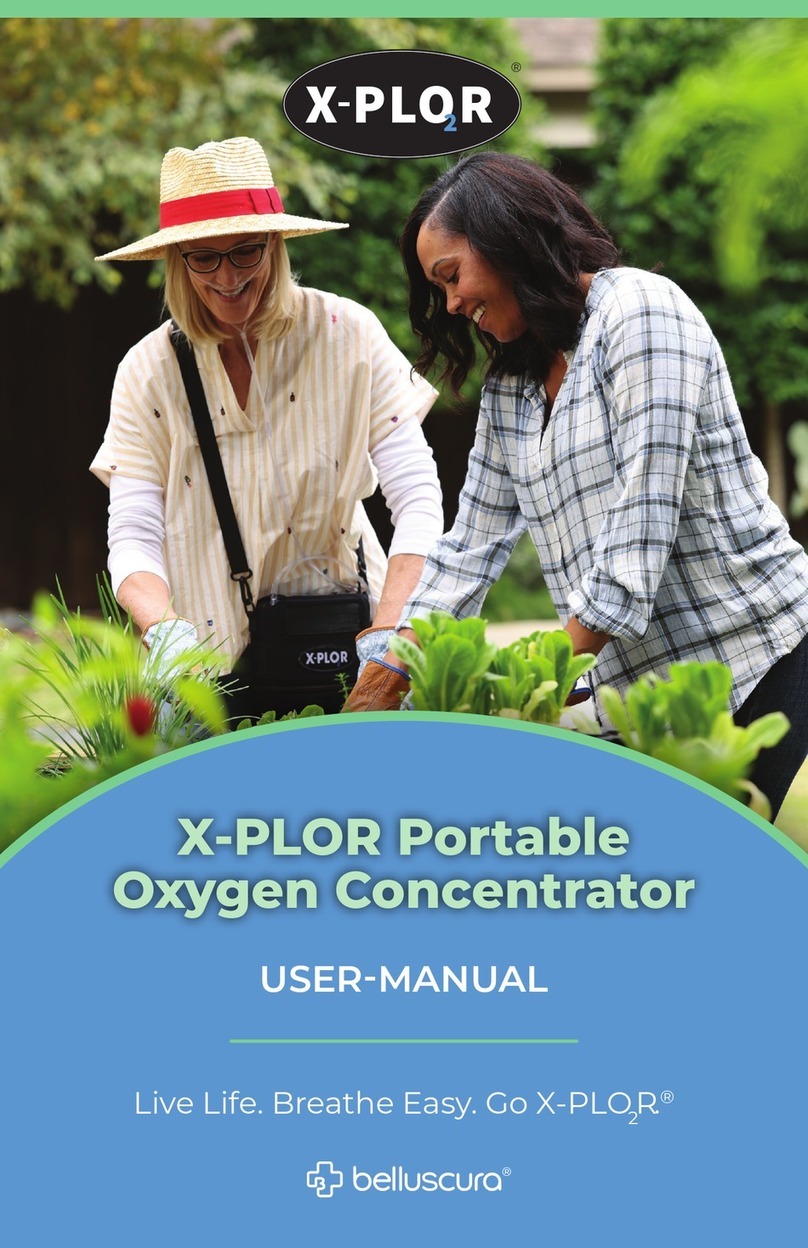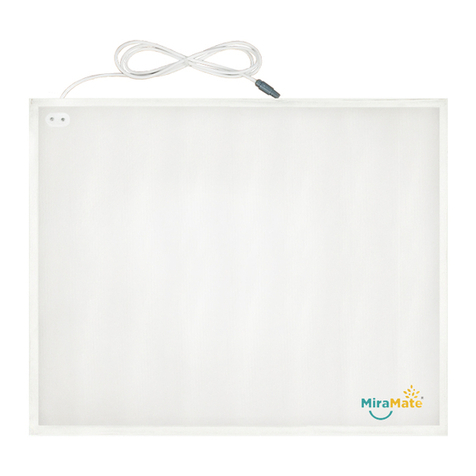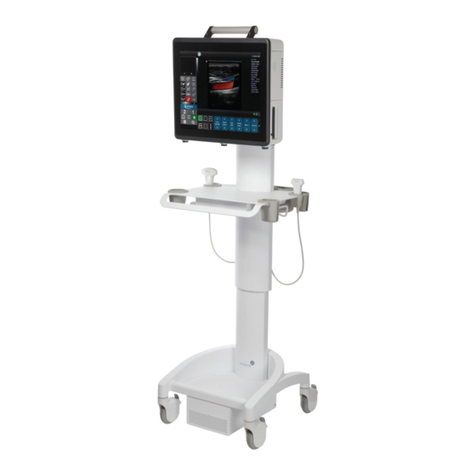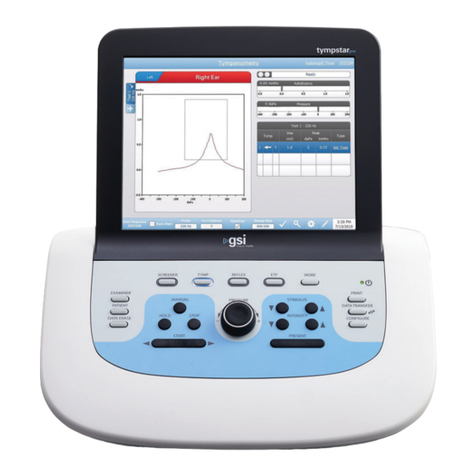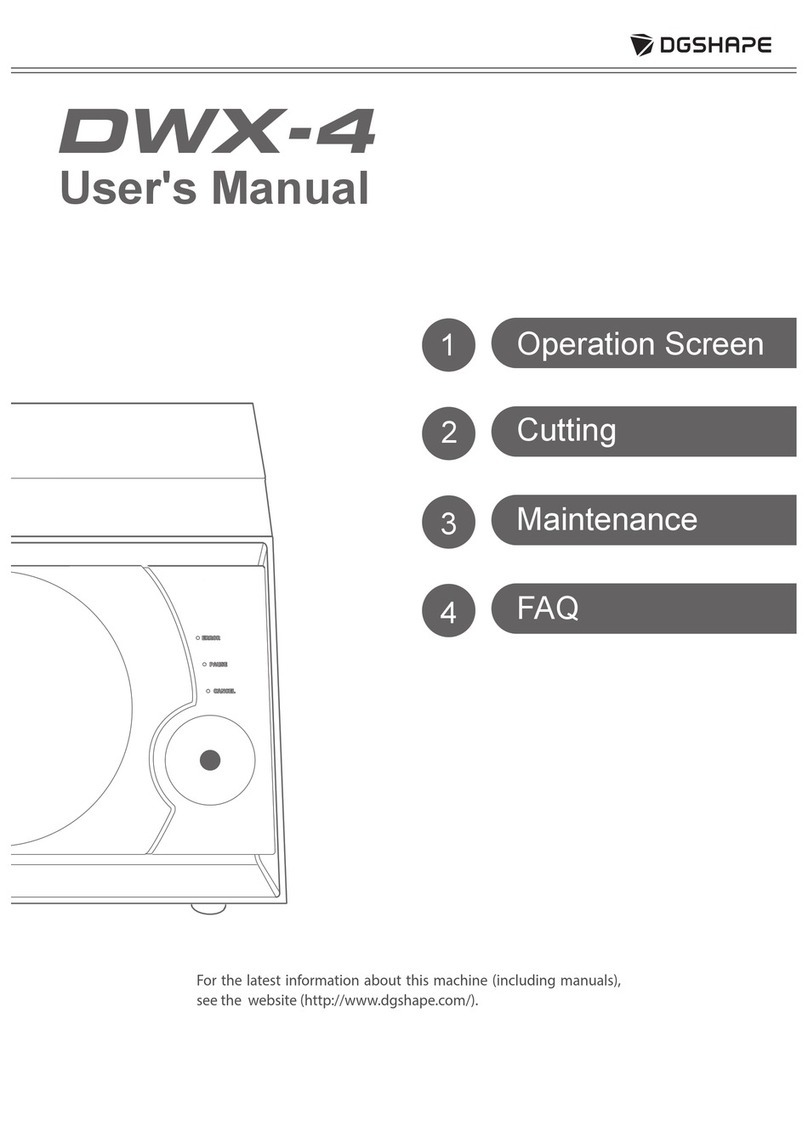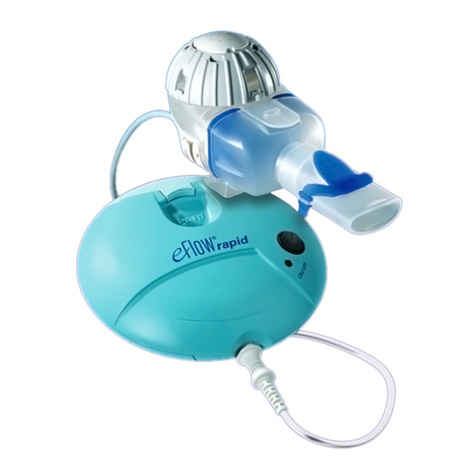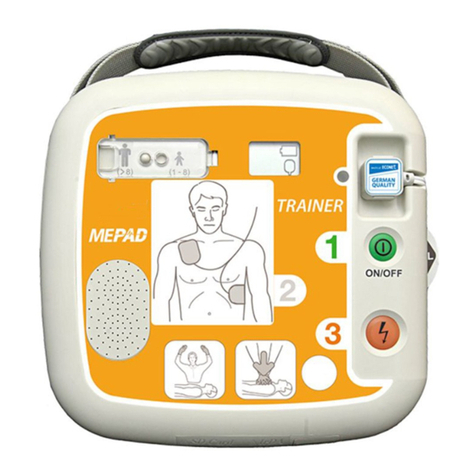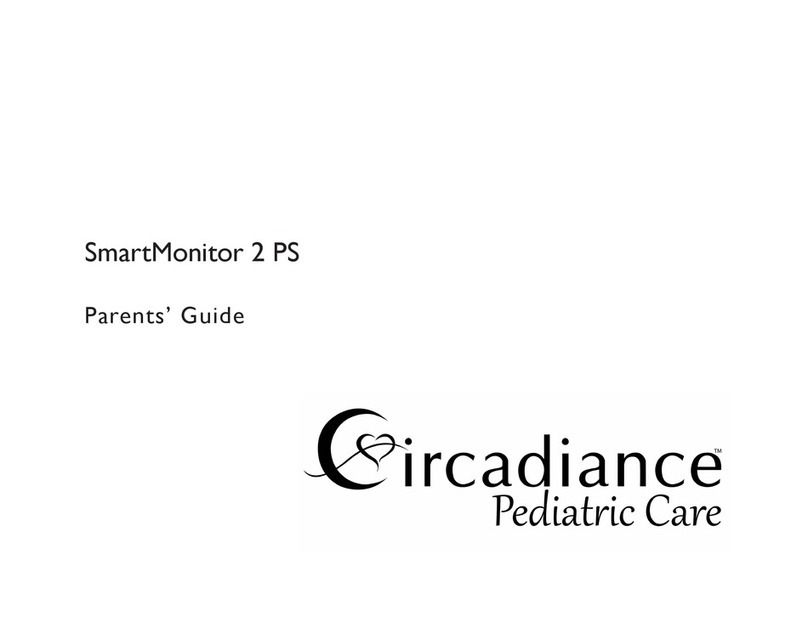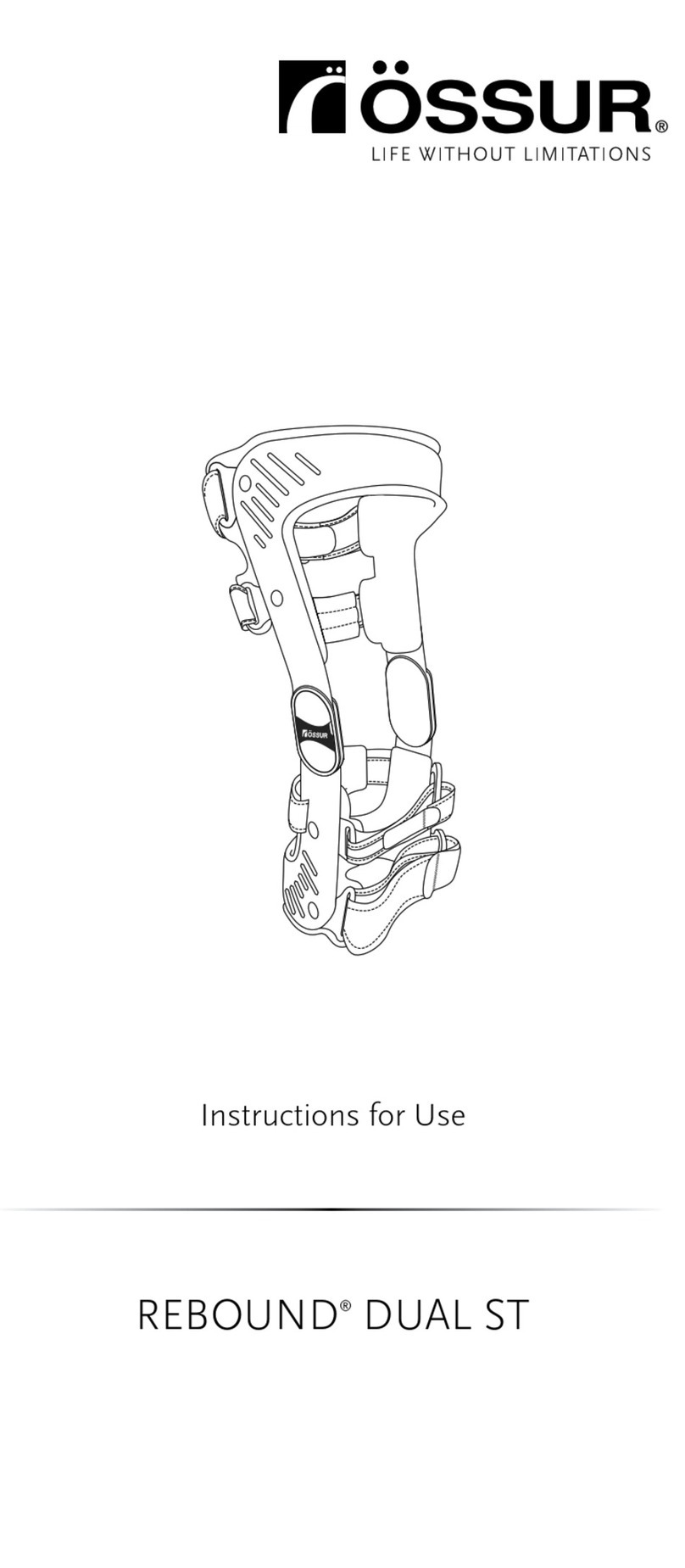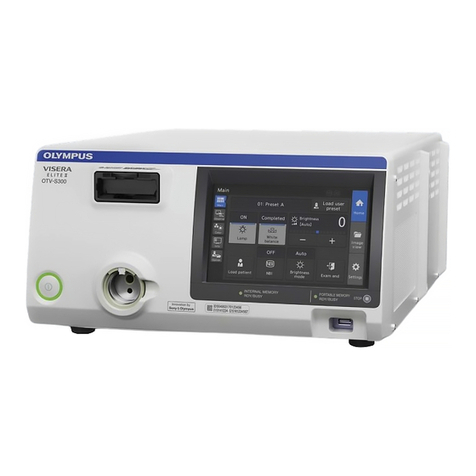Datascope Accutorr Plus User manual

Datascope’


INTRODUCTION
Chapters
.
Operation
.
Theory
of
Operation
.
Specifications
.
Repair
Information
«
Schematics
.
Parts
.
Calibration
on
A
MN wR
WwW
NY
본
.
Preventive
Maintenance
A
complete,
detailed
table
of
contents
begins
on
page
iii.
Also,
on
the
first
page
of
each
chapter
a
table
of
contents
for
that
chapter
is
provided.
FOREWORD
This
Service
Manual
(P/N
0070-00-0429)
is
intended
as
a
guide,
for
technically
qualified
personnel,
to
use
during
repair
and
calibration
procedures
for
the
Accutorr
Plus
(part
number
0998-00-0444-XX).
NOTE:
See the
serial
number
label
on
the
rear
panel
of
the
unit
for
part
number
identification.
This
manual
also
includes
information
on
the
Recorder
and
Predictive
Temperacure
Modules.
The
information
in
this
manual
has
been
divided
into
the
eight
chapters
listed
above.
This
publication
may
have
been
updated
to
reflect
product
design
changes
and/or
manual
improvements.
Any
such
changes
to
this
manual
would
be
accomplished
by
supplying
replacement
pages
and
instructions
for
inserting
or
affixing
them
into
the
manual.
NOTE
Unauthorized
servicing
may
void
the
remainder
of
the
warranty.
Check
with
the
factory
or
with
a
local
authorized
Datascope
representative
to
determine
the
warranty
status
of
a
particular
instrument.
NOTE:
This
produce
is
year
2000
compliant.
Copyright
©
Datascope
Corp.,
1999.
Printed
in
U.S.A.
All
rights
reserved.
Contents
of
this
publication
may
not
be
reproduced
in
any
form
without
permission
of
Datascope
Corp.
Accutorr
Plus,
Service
Manual
Chapter
1
-
Operation


TABLE
OF
CONTENTS
INTRODUCTION
ee
10
OPERATION..................
κ
ον
ーー
1.1
Introducrdon.................
еее
еенньня
1.2
Controls
and
Indicators.
................................
1.2.1
Front
Panel..............................,,..
1.2.2
RearPanel
...........................
4.6...
1.2.3
Predictive
Thermometer
Module
.................
1.2.4
Recorder
Module
.............................
1.3
Operation.
..........................................
1.3.1
Serting-Up
/
Turning
Power
On..................
1.3.2
Patient
Setup
and
Room/Bed
Assignment...........
1.3.2.1
Selecting
the
Patient
Size
.......................
1.3.2.2
Cuff
Inflation
Pressure
.
........................
13.23
Room
Number
and
Bed
Letter
...................
1.3.3
Manual
NIBP
Measurements
and
General
NIBP
Measurement
Information.
......................
1.3.3.1
NIBP
Pressure
Limit
Fail Safe
1332
Cuff
Inflation Time.
...........................
1.3.3.3
Automatic
Adjustment
of
Cuff
Inflation
Pressure
(Adaptive
Inflation)
...........................
1.3.4
Automatic
NIBP
Measurements
(Interval
Mode)
.....
1.3.4.1
Canceling
an
Automatic
NIBP
Measurement
........
1.3.4.2
Changingthelntemalsetting....................
1.3.4.3 Effects
of
Changing
the
Room
Number
and
/or
Bed
Letter
on
the
Interval
Setting
....................
1.3.4.4
Start
and
Deflate
Functions.
.....................
1.3.5
Aiarms
..
ν
ων
ω
ων
ω
νο
ον
ων
ενω
ων ως
φως
ως
1.3.5.1
Setting
Alarm
Limits
..........................
1.3.5.2
Alarm
Violarions
.............................
1353
Howto
Mute
Alarms
..........................
1.3.5.4
Alarms
and
Changing
the
Room
Number
and/or
Bed
Letter..........
2...
ee
eee
1.3.6
To
View
and
Delete
Stored
Data
(Trend
Mode).......
1.3.6.1
To
View
the
Stored
Measurements
on
the
Accutorr
Plus
NIBP
«νεο
ν
εν
εν
ων
ν
νο
κενο
ων
εν
εως
1.3.6.2
To
View
the
Stored
Measurements
on
the
Accutorr
Plus
NIBP
with
Trend
Screen
and
the
Accutorr
Plus
NIBP
with
Trend
Screen
and
SpO2................
Accutorr
Plus
Service
Manual
Introduction
iii

2.0
2.1
2.2
1.3.6.3
To
Delete
the
Stored
Measurements
on
all
Models
of
the
Accutorr
Plus
.....................
1-29
1.3.7
Setting
the
Alarm
Volume
and
Beep
Volume
........
1-30
1.3.8
Setting
the
LCD
Contrast
(View
Angle
Adjustment)
..
1-31
1.3.9
Display
Time
Out
Mode........................
1-32
1.3.10
SpO2
Measurements
(Accutorr
Plus
model
with
SpO2).
1-33
1.3.10.1
Datascope
Pulse
Oximetry
Sensors
................
1-33
1.3.10.2
Sequence
for
Establishing
SpO2
with
Nellcor®
Pulse
Oximetry*
..................................
1-37
1.3.10.3
Sequence
for
Establishing
SpO2
with
Masimo®
Pulse
Oximetry*
.................................
1-40
13.11
Temperature
Measurement
(optional)
..............
1-43
1.3.11.1
Predictive
Thermometer
Measurements
............
1-43
1.3.11.2
How
to
Apply
Probe Cover
(PTM)................
1-43
1.3.11.3
How
to
Take
Oral,
Rectal,
and
Axillary
Temperatures
.
1-44
1.3.11.4
Storing
Temperature
Measurements
...............
1-45
1.3.12
Recorder
(optional)............................
1-46
13.13
How
to
Set
the
Clock
(Date
and
Time).............
1-47
1.3.14
Battery
Operation...............
ω
εν
κ
ων
1-48
1.3.15
User
Configuration............................
1-49
1.3.16
Status
and
Error
Codes
.........................
1-51
1.3.17
How
to
Attach
Optional
Thermometer
and
RecorderModules.............................
1-52
1.3.18
Placement
of
the
Quick
Reference
Card
............
1-53
1.3.19
Placement
of
Recorder
Paper
Loading
Label
.........
1-54
THEORY
OF
OPERATION
...........................
2-1
Block
Diagrams
......................................
2-1
Detailed
Circuit
Descriptions.
...........................
2-2
2.2.1
LED/CPU
Module,
0670-00-0650-03,-04..........
2-9
2.2.1.1
Hardware
Overview
...........................
2-9
2.2.1.2
Software
Overview
............................
2-9
2.2.1.3
Detailed
Hardware
Description.
..................
2-10
2.2.2
NIBP
Module,
Linear
Bleed
.....................
2-17
2.2.3
Recorder
Module
.............................
2-20
2.2.4
Predicrive
Thermometer
Module
.................
2-21
2.2.5
SpO2
Module
(Accutorr
Plus
with
SpOz
only)
.......
2-22
2.2.6
Main
Power
Supply............................
2-25
2.2.7
Communication
Board
.........................
2-26
2.2.8
LCD
Inverter
Module
-
0670-00-0649
.
............
2-28
2.2.9
Nelicor®
MP
304
SpO>
Circuit
Board
Theory
of
Operation
...........................
2-29
2.2.10
Interface
Nellcor®
Board
Theory
of
Operation
.......
2-30
iv
Revised
12/20/00
Accutorr
Plus
Service
Manual
Introduction

2.2.11
Masimo
SET?
Technology.
.....................
2-31
2.2.12
Masimo
Interface
Board
Theory
of
Operation
........
2-32
3.0
SPECIFICATIONS
...........................,......
3-1
3.1.
PerformenceSpecificatilons..............................
3-1
3.2
Safety
Characteristics
..................................
3-6
3.3
Physical
Characteristics
................................
3-7
3.4
Environmental
Characteristics
...........................
3-7
3.5
Electrical
Ratings
ーー
3-7
3.6
Agency
Compliance
.........................,.........
3-8
3.7
Electromagnetic
Compatibility.
..........................
3-8
4.0
REPAIR
INFORMATION
............................
4-1
4.1
Introduction.
........................................
4-1
4.2
Safety
Precautions.
....................................
4-2
4.3
General
Troubleshooting
Guidelines
......................
4-2
4.4
Test
Equipment
Required
.......
A...
4-3
4.5
Troubleshooting
(Problem
Isolation)
......................
4-4
451
Isolating
the
Problem,
System
Level
...............
4-5
4.5.2
Isolating
the
Problem
within
the
Main
Unit.........
4-5
4.5.3
Isolating
the
Problem
with
Optional
Accessory
Modules.
. .
4-6
45.4
Clinical
Issues.
...............................
4-6
4.6
Disassembly
Instructions
...............................
4-9
4.6.1
Removal
of
the
Rear
Housing
(27)
................
4-9
4.6.2
Removal
of
che
Front
Bezel
(2)...................
4-9
4.6.3
Removal
of
the
Keyboard
Assembly
(4).............
4-9
4.6.4
Removal
of
the
CPU
Board
Assembly
(8)
...........
4-10
4.6.5
Removal
of
the
NIBP
Circuit
Assembly
(30)
........
4-10
4.6.6
Removal
of
the
Power
Supply
Assembly
(41)
........
4-10
4.6.7
Removal
of
the
Motor
Filter
and
LCD
High
Voltage
Assembly
(35)
....................
4-11
4.6.8
Removal
of
the
NIBP
Air
Pump
Assembly
(37)
......
4-11
4.6.9
Removal
of
the
LCD
Dispiay
Assembly
and
Back
Light
(5)
4-11
4.6.10
Removal
of
the
SpOz
Circuit
Board
(40)............
4-11
4.6.11
Removal
and
Replacement
of
the
Internal
Sealed
Lead
Acid
or
Li-lon
Battery
.....................
4-12
4.6.12
Removal
of
the
AC
Input
Receptacle
Assembly
(16).
.
.
4-12
4.6.13
Thermal
Printer
(Optional
Module)
...............
4.12
4.6.14
Thermometer,
Predictive
(Optional
Module)
........
4-13
4.6.15
AccuTemp
IR,
Infrared
Thermometer
(optional
module)
....................................
4-13
4.6.16
AccuTemp
IR
Mounting
Cradle..................
4.13
Accutorr
Plus
Service
Manual
Introduction
.
Revised
12/20/00

5.0
6.0
6.1
6.2
6.3
6.4
6.5
6.6
6.7
6.8
6.9
7.0
7.1
7.2
7.3
74
7.5
4.6.17
Communication
Board
(45)......................
4-13
ASSEMBLY
AND
SCHEMATIC
DIAGRAMS
............
5-1
REPLACEMENT
PARTS
..,...............,..........
6-1
Introduction.
........................................
6-1
Available
Replacement
Parts
and
Sub-Assemblies
............
6-1
Product
Variations
and
Options
..........................
6-1
ExchangeProgram............................
ων
ων
6-1
Replacement
Parts
Pricing
Information
....................
6-2
Ordering
Information.
.................................
6-2
Abbreviations.
................,......................
6-3
Isometric
Drawings
and
Parts
List
........................
6-5
6.8.1
Accutorr
Plus
Isometric
Parts
List (All
Models)
......
6-5
6.8.2
Recorder
Module
Isometric
Parts
List..............
6-13
6.8.3
Predictive
Temperature
Module
Isometric
Parts
List.
. .
6-15
6.8.4
Mobile
Stand
Type
1
(Gray
Base)
Assembly
Parts
List
.
6-17
6.8.5
Mobile
Stand
Type
2
(Black
Base)
Assembly
Parts
List
.
6-19
6.8.6
Mounting
Options
............................
6-19
Circuit
Board
Parts
Lists.
...............................
6-21
CALIBRATION...............
esse
7-1
Introduction.
........................................
7-3
Warnings
and
Guidelines.
..............................
7-3
Test
Equipment
and
Special
Tools
Required.
................
7-3
Power-Up
Sequence,
Internal
Testing.
.....................
7-4
Service
Diagnostics.
...................................
7-4
751
Introduction
(Hidden
Key)......................
7-4
7.5.2
Software
Version
Test
(0a,
Ob)....................
7-5
753
Keypad
Test
.................................
7-6
7.5.4
LED
Test
(2a,
2b).............................
7-7
7.5.5
Communications
Test
(3a,
3b)
...................
7-7
7.5.6
Recorder
Test
(4)
.............................
7-7
7.5.6.1
Recorder
Print
Head
Adjustment
.................
7-8
7.5.7
Pump
Test
(5)........:........................
7-8
7.5.8
Leak
Test
(7).................................
7-9
7.5.9
Over
Pressure
Test
(8a,
8b,
8c)...................
7-10
7.5.10
Pulse
Channel
DC
Offset
Test
(9a,
9b,
9c)
..........
7-10
7.5.11
Pulse
Channel
Average
Noise
Test
(10a,
10b,
10c)....
7-11
7.5.12
Main
Pressure
Transducer
Verification
Test
(118,
11b,11c).........................,..,..
7-11
vi
Revised
12/20/00
Accutorr
Plus
Service
Manual
Introduction

7.5.13
Verification
of
Accutorr
Plus
Pneumatic
Performance,
Using
the
“Cufflink”
NIBP
Emulator
(11d)
.........
7-11
7.5.14
Check
Over
Pressure
Reference
(12a,
12b,
12c).......
7-12
7.5.15
Main
Pressure
Transducer
Calibration
(llc)
.........
7-12
7.5.16
Over
Pressure
Transducer
Calibration..............
7-13
7.5.17
Battery
Selection
(13)..........................
7-13
7.6
Predictive
Thermometer
Verification
and
Calibration..........
7-14
7.6.1
Temperature
Accuracy
Verification
with
the
Predicrive
Temperature
Simulator
................
7-14
7.62
Water
Bath
Method
...........................
7-15
7.63
System
Calibration
Procedure
....................
7-15
7.6.4
Temperature
Verification
Test,
Infrared
Thermometer
................................
7-16
7.6.5
Low
Battery
Sensing
...........................
7-17
7.7
Battery
Test
for
Accutorr
Plus
...........................
7-18
7.74
Low
Battery
Indicator..........................
7-18
7.7.2
Set
the
Current
Time
..........................
7-18
7.8
NIBP
Normal
Operation
...............................
7-19
7.9
Trend
Memory
Initialization
............................
7-20
7.10
SpO2
Normal
Operation
(Accutorr
Plus
with
SpO2
only).
......
7-20
8.0
PREVENTIVE
MAINTENANCE.............,.........
8-1
8.1
Introduction.........................................
8-1
8.2
Limitations
of
Physiological
Simulators
....................
8-1
8.3
Preventive
Maintenance
Schedule............
l
8-2
8.3.1
Mechanical
and
Physical
Visual
Inspection
(One
Year
Interval)............................
8-2
8.3.2
Electrical
Safety
and
Performance
Checks
(One
Year
Interval)............................
8-2
Accutorr
Plus
Service
Manual
Revised
12/20/00
vii
Introduction


1.0
OPERATION
CONTENTS
OF
THIS
CHAPTER
Page
1.1
Inttoduction..
ν
νεο
νο
νεο
ών
οω
νο
ω ο
νε
ον
νο
1-1
1.2
Controls
and
Indicators
................................
1-3
13
Operatlon................
0.
eee
1-17
1.1
INTRODUCTION
This
section
of
the
Service
Manual
(P/N
0070-00-0429)
is
provided
as
a
review
of
the
Accutorr
Plus
NIBP,
the
Accutorr
Plus
NIBP
with
Trend
Screen
and
the
Accutorr
Plus
NIBP
with
Trend
Screen
and
SpO2
functions
and
operation.
The
reader
is
encouraged
to
refer
to
the
Operating
Instructions,
P/N
0070-00-0428,
for
more
complete
details.
Accutorr
Plus,
Service
Manual
Revised
06/25/99
Chapter
1
-
Operation
1-1

Accutorr
Plus,
Service
Manual
Chapter
1
-
Operation

1.2
CONTROLS
AND
INDICATORS
This
section
of
the
Service
Manual
identifies
and describes
each control
and
display
of
the
Datascope
Accutorr
Plus
NIBP,
the
Accutorr
Plus
NIBP
with
Trend
Screen
and
the
Accutorr
Plus
NIBP
with
Trend
Screen
and
SpOo.
For
step-by-step
operating
instructions
see
Chapter
1.3,
“Operation”.
The
following
is
a
list
of
all
controls,
connectors
and
indicators,
their
item
number
and
the
page
number.
The
item
number
refers
to
the
call
outs
on
the
drawings
within
this
chapter.
The
page
number
refers
to
the
page
where
the
description
of
the
item
can
be
found.
CONTROL
FRONT
PANEL
vom
EN
는
o
ピロ
U
du
N
=
은
16.
17.
18.
19.
20.
21.
22.
23.
24.
25.
26.
27.
28.
29.
NIBP
Systolic
Display
NIBP
Diastolic
Display
NIBP
MAP
Display
Pulse
Rate
Display
NIBP/SpO2
Pulse
Rate
Indicator
9ΡΟ2
Display
Liquid
Crystal
Display
(LCD)
Menu
Key
LCD
Up
Arrow
Key
.
LCD
Down
Arrow
Key
.
Select
Key
.
Print
Key
Print
Indicator
Defaults
Key
.
Datascope,
Nellcor
®
or
Masimo
SpO2
Connector
AC
Power
Indicator
Battery
Indicator
NIBP
Connector
On/Standby
Key
Memory
Full
Indicator
Delete
Info.
Key
Data
Scan
Key
Data
Scan
Indicator
Room/Bed
Key
Bed
Letter
Display
Room
Number
Display
Patient
Info.
Down
Arrow
Key
Patient
Info.
Up
Arrow
Key
Set
Alarms
Key
Page
#
1-8
1-8
1-8
1-8
1-8
1-8
1-8
1-8
1-8
1-8
1-9
1-9
1-9
1-9
1-9
1-9
1-9
1-9
1-9
19
1-10
1-10
1-10
1-10
1-10
1-10
1-10
1-10
1-11
CONTROL
Page#
30.
Mute
Key
1-10
31.
Mute
Indicator
1-11
32.
Timer/Temp
Key
1-11
33.
Interval/Elap.
Time/Temp
Display
1-11
34.
Interval
Key
1-11
35.
Interval
Indicator
1-11
36.
Deflate
Key
1-12
37.
Patient
Setup
Key
1-12
38.
Start
NIBP
Key
1-12
39.
Scart
NIBP
indicator 1-12
40.
Patient
Size
Indicators
1-12
41.
Hidden
Key
1-12
REAR
PANEL
42.
Thermometer
Module
Connector
1-13
43.
Equipotential
Lug
1-13
44,
AC
Power
Connector
1-13
45.
Communications
Connector
1-13
46.
Datascope
Connector
1-13
47.
Pole
Mounting
Handle
and
Cam
1-13
48.
Recorder
Module
Connector
1-13
PREDICTIVE
THERMOMETER
MODULE
49.
Probe
Cover
Holder
1-14
50.
Probe
Chamber
1-14
51.
Probe
Connector
1-14
RECORDER
MODULE
52.
Paper
Door
1-15
53.
Paper
Tear
Edge
1-15
Accutorr
Plus
Service
Manual
Chapter
1,
Operation
Revised
02/15/00
1-3

1.2.1
Front
Panel
4
40
\
\
\
4
,
Accutotr
Plus“
|
39
38
2
37
36
35
34
3
a
TIMER/TEMP
.
23
32
5
INTERVAL
ELAPTINE
TEMP
31
p
30
+
eo
SET
MUTE
29
。
Os)
ον
고
一
一
of
26
o
PATIENT
INFOS
A
o
24
CSD
AS
7
Dr
a
。
2223
la
83
63
O8.
123/61
84
60
98.5
24
8
E
162.
e
58
97.6
BA
=
2
2
19
Figure
1-1
Front
Panel
-
Accutorr
Plus
NIBP
with
Trend
Screen
and
Datascope
Sp02
Accutorr
Plus
Service
Manual
Chapter
1,
Operation

M
A
40
e”
\
>
기
|
Datascope
coto
Accutorr
Plus
39
38
2
37
35
3
4
33
32
5.
31
30
29
s
28
28
25
24
7
i
22-28
:
4
83
©
8.
02:58
123/61
84
60
985
97
21
8
02:35
127/62
83
58
976
96
:
co
1732
EQ
96
20
62
84
59
982
97
>
19
=
Figure
1-2
Front Panel
-
Accutorr
Plus
NIBP
with
Trend
Screen
and
Nellcor®
or
Masimo
SpO2
Accutorr
Plus
Service
Manual
Chapter
1,
Operation
„Revised
02/15/00
1-5

=
Accutorr
Plus”
圖
ЧИ
LL
LT
LI
amm,
--
či
σα
39
37
36
32
31
30
27
25
26
24
23
114/64
123/61
12762
83.
21
20
19
Figure
1-3
Front
Panel
-
Accutorr
Plus
NIBP
with
Trend
Screen
Accutorr
Plus
Service
Manual
Chapter
1,
Operation

40
Accutorr
Plus”
2
43 14
16 17
Figure
1-4
Front
Panel
-
Accutorr
Plus
NIBP
Accutorr
Plus
Service
Manual
Chapter
1,
Operation

10.
NIBP
Systolic
Display
Displays
the
systolic
blood pressure
data
from
NIBP
measurements.
It
is
also
used
to
display
NIBP
error
codes
and
systolic
alarm
limits.
NIBP
Diastolic
Display
Displays
the
diastolic
blood
pressure
data
from
NIBP
measurements.
It
is
also
used
to
display
diastolic
alarm
limits.
NIBP
MAP
Display
Displays
the
mean
arterial
pressure
(MAP)
information
from
NIBP
measurements.
During
a
measurement,
it
will
display
the
cuff
pressure.
It
is
also
used
to
display
the
MAP
alarm
limits
and
the
inflation
pressure
when
selecting
the initial
inflation
pressure.
Pulse
Rate
Display
Displays
the
pulse
rate
information
from
either
the
NIBP
measurement
or
the
SpO2
reading
(Accurorr
Plus
model
with SpOz).
It
is
also
used
to
display
pulse
rate
alarm
limits.
NIBP/SpO2
Pulse
Rate
Indicator
When
the
pulse
rate
displayed
is
based
on
an
NIBP
measurement,
then
NIBP
is
illu-
minated.
When
the
pulse
rate
displayed
is
based
on
an
SpO2
measurement
(Accutorr
Plus
model
with
SpO2),
then
SpO
is
illuminated.
SpOz
Display (Accutorr
Plus
model
with
SpO2)
Displays
the
%SpO2
measurement
information.
This
area
is
also
used
to
display
the
%SpOz
alarm
limits.
Liguid
Crystal
Display
(LCD)
(Accutorr
Plus
models
with
Trend
Screen)
The
Liguid
Crystal
Display
(LCD)
is
used
to
display
previous
measurements
(trend
list)
for
the
selected
patient,
or
a
menu
that
controls
the
beep
volume
and
alarm
volume.
Menu
Key
(Accutorr
Plus
models
with
Trend
Screen)
This
key
is
used
to
toggle
berween
the
trend
list
screen
and
the
menu
screen
in
the
LCD.
When
the
back
light
in
the
LCD
is
off,
pressing
this
key
turns
it
on.
This
key
is
also
used
to
adjust
the
LCD
contrast.
Press
and
hold
the
key
for
two
beeps
to
enter
the
adjustment
mode.
Use
the
Atrow
keys
(9
and
10)
to
change
the
contrast.
LCD
Up
Arrow
Key
(Accutorr
Plus
models
with
Trend
Screen)
This
key
is
used
to
scroll
the
trend
data
so
that
more
recent
measurements
are
displayed
in
the
LCD.
When
the
back
light
in
the
LCD
is
off,
pressing
this
key turns
it
on.
This
key
is
also
used
to
adjust
the
LCD
contrast
when
in
the
adjustment
mode.
Use
the
Menu
key
(8)
to
enter
the
adjustment
mode.
LCD
Down
Arrow
Key
(Accutorr
Plus
models
with
Trend
Screen)
This
key
is
used
to
scroll
the
trend
data
so
that
older
measurements
are
displayed
in
the
LCD.
When
the
back
light
in
the
LCD
is
off,
pressing
this
key
turns
it
on.
This
key
is
also
used
to
adjust
the
LCD
contrast
when
in
the
adjustment
mode.
Use
the
Menu
key
(8)
to
enter
the
adjustment
mode.
Accutorr
Plus
Service
Manual
Chapter
1,
Operation

11.
Select
Key
(Accutorr
Plus
models
with
Trend
Screen)
When
the
menu
screen
is
displayed
in
the
LCD,
this
key
is
used
to
select
the
menu
items,
When
the
back
light
in
the
LCD
is
off,
pressing
this
key
turns
it
on.
12.
Print
Key
Press
this
key
to
print
all
stored
information
for
the
selected
patient.
Press
to
stop
a
printing
that
is
in
process.
Press
and
hold
this
key
(2
single
beep
tones,
approx.
3
seconds)
to
change
the
print
mode
berween
Continuous
and
Request.
When
in
the
Continuous
mode,
the
PRINT
Indicator
LED
is
illuminated.
When
loading
in
a
new
roll
of
recorder
paper,
press
this
key
to
feed
the
paper
through
the
printer.
13.
Print
Indicator
This
indicator
is
illuminated
when
continuous
printing
of
measurements
is
selected.
14.
Defaults
Key
Press
and
hold
this
key
(2
single
beep
tones,
approx.
3
seconds)
to
reset
all
parameters
back
to
the
hospital
default
settings.
This
includes
alarms,
inflation
pressure,
interval,
etc...
When
in
the
process
of
making
a
change
to
a
setting,
you
can
return
to
the
original
setting
by
momentarily
pressing
this
key.
To
enter
the
User
Configuration,
press
and
hold
this
key
(1
beep
tone),
while turning
the
unit
on.
See
section
1.3.15
for
details
on
default
settings
and
User
Configuration.
15.
SpO2
Connector
(Accutorr
Plus
model
with
Datascope,
Nellcor®
or
Masimo
SpO2)
This
connector
is
used
to
attach
Datascope,
Nellcor®
or
Masimo
SpO2
sensors.
16.
AC
Power
Indicator
This
green
LED
illuminates
whenever
AC
power
is
applied
co
the unit.
17.
Battery
Indicator
This
green
LED
illuminates
whenever
the
unit
is
operating
on
battery
power.
The
LED
will
flash
when
the
battery
requires
charging.
When
the
LED
begins
flashing,
approximately
30
minutes
of
battery
cime
remain
on
the
Accutorr
Plus
NIBP
(20
minutes
on
the
Accutorr
Plus
NIBP
with
Trend
Screen
and
10
minutes
on
the
Accutorr
Plus
NIBP
with
Trend
Screen
and
SpOn).
18.
NIBP
Connector
This
connector
is
used
to
attach
specified
NIBP
hoses.
19.
On/Standby
Key
This
key
is
used
to
activate
the
unit,
enabling
it
to
begin
taking
measurements.
The
unit
does
not
have
to
be
“ON”
for
the
internal
battery
to
charge.
However,
the
unit
does
need
to
be
plugged
into
an
AC
receptacle
for
the
battery
to
be
charging.
20.
Memory
Full
Indicator
This
LED
indicator
flashes
when
80
-
99
of
the
100
available
entries
of
trend
are
used.
This
LED
is
on
continuously
when
100
are
used.
Delete
measurements.
manually
using
the
DELETE
INFO.
key
or
the
unit
will
automatically
delete
the
oldest
measurement
for
the
current
patient.
NOTE:
The
unit
will
also
automatically
delete
data
that
is
24
hours
old.
Accutorr
Plus Service
Manual
Chapter
1,
Operation
Revised
02/15/00
1-9

21.
Delete
Info.
Key
Press
the
Data Scan
key
to
enable
the
Delete
Info.
key
(Accutorr
Plus
without
Trend
and
SpO2
only).
Once
enabled,
press
and
hold
this
key
(1
beep
tone,
approx.
3
seconds)
to
delete
the
most
recent
reading
when
it
is
displayed.
When
displaying
any
measurement,
press
and
hold
this
key
(2
beep
cones,
approx.
6
seconds)
to
delete
all
information
for
the
currently
selected
patient.
Press
and hold
at
power
up
to
delete
all
information
for
all
patients.
22.
Data
Scan
Key
Press
this
key
(1
beep
tone)
to
view
previous
measurements
for
the
selected
patient
on
the
Aceutorr
Plus
NIBP
and
to
enable
the
Delete
Info.
key
(Accucorr
Plus
with-
out
Trend
and
SpO2
only).
The
LED
indicator
next
to
the
key
illuminates.
On
the
Accutorr
Plus
NIBP,
use the
Patient
Info.
Up
&
Down
Arrow
keys
(27
&
28)
to
scroll
through
the
stored
measurements
for
the
selected
patient.
On
all
models
of
the
Accutorr
Plus,
press
and
hold
this
key
(2
beep
tones,
approx.
6
seconds)
to
scan
all
of
the
rooms
and
beds
for
stored
measurements,
Press
the
Data
Scan
key
again
to
stop
on
a
particular
room/bed.
Press
the
Data
Scan
key
again
to
exit this
view
mode.
23.
Data
Scan
Indicator
This
LED
indicator
is
illuminated
when
viewing
prior
data.
24.
Room/Bed
Number
Key
Press
this
key
to
change
the
displayed
Room/Bed.
After
pressing
this
key
use
the
Patient
Info.
Up
&
Down
Arrow
keys
(27
&
28)
to
change
the
Room/Bed.
This
key
is
also
used
when
selecting
a
User
Configuration
item.
25.
Bed
Letter
Display
This
display
is
used
to
show
the
current
patient
bed
letter.
It
is
also
used
to
display
status
codes
for
NIBP,
SpO2
and
Temperature
and
to
display
User
Configuration
items,
26.
Room
Number
Display
This
display
is
used
to
show
the
current
patient
room
number.
It
is
also
used
to
display
status
codes
for
NIBP,
SpO2
and
Temperatute,
indicates
which
alarm
is
being
set
(Hi
or
Lo),
and
displays
a
User
Configuration
item.
27.
Patient
Info.
Down
Arrow
Key
This
key
is
used
to
decrement
the
alarm
limits
when
they
are
shown
on
the
LED
displays
and
to
decrement
the
hours,
minutes,
month,
day
and
year
in
the
clock
set
mode.
This
key
is
also
used
to
change
the
Room/Bed,
to
scroll
through
previous
data
and
to
change
initial
inflation
pressure.
28.
Patient
Info.
Up Arrow
Key
This
key
is
used
to
increment
the
alarm
limits
when
they
are
shown
on
che
LED
displays
and
to
increment
the
hours,
minutes,
month,
day
and
year
in
the
clock
set
mode.
This
key
is
also
used
to
change
the
Room/Bed,
to
scroll
through
previous
data
and
to
change
initial
inflation
pressure.
1-10
Accutorr
Plus
Service
Manual
Chapter
1,
Operation
Other manuals for Accutorr Plus
2
Table of contents
Other Datascope Medical Equipment manuals
